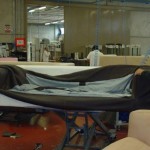Have you ever thought about how much time and effort it takes to produce the chair and sofa you sit on, or the bed you sleep on?
I can certainly relate to the chapters we studied relating to product design, and quality management and international standards. Working for a furniture company, I get to watch training videos of how our products are produced. I must admit furniture design is very intense. Every chair, bed, and table has to be designed according to the ergonomics of the human body, as well as international standards; since our furniture is sold worldwide. Every piece is designed to assure comfort, convenience and style. Along with product design, the main focus has now become on “ecodesign”, the following is the statement our company shares regarding sustainability: “Like any industrial product, furniture is a source of environmental impact. Thereby participating in its degradation to the extent that it requires materials and energy, it must be transported and packaged, it can be maintained and repaired, and it will one day become a waste… This policy is now inseparable to our commitments of quality and creativity.” This statement clearly shows our company’s use of Life Cycle Assessment (LCA).
Our furniture pieces are designed by top European designers, creators and architects. Every piece of furniture produced goes through a very long production cycle. Furniture design begins with creativity, followed by design with the use of software such as Computer-aided design (CAD), and Design for manufacture and assembly (DFMA). Once the design is completed digitally, a prototype is then produced with the use of human labor as well as Computer-aided manufacturing (CAM). The prototype is then tested by the designer and management.
Quality management is of crucial importance when it comes to the furniture we sell. To assure quality our furniture is only made with solid wood from environmentally sustainable forests, and the fabrics and leathers used in our furniture go through a series of detailed tests. Our fabrics go through a rub test, known as Martindale Test, which tests a fabric’s durability by counting the number of rubs it takes for a fabric to wear out. If a fabric wears out before 30,000 rubs then it is not durable, the most durable are fabrics from 30,000 to 100,000 rubs. Our leathers also go through a series of different testing methods such as absorbency, burning and stretching. A thorough inspection of the materials used is done by experts who “have the eye” to spot mistakes or natural defects. Some natural defects are usually found in leather. Since it comes from cows, some cows might get scars which are then found in the leather. A piece of furniture will only go into production, once it meets the European Furniture Standards and passes quality control.
Now that you have a better understanding about the creation of sustainable furniture, can you relate the importance of product design and quality management to other daily life objects?



That was a very informative and interesting read Dana. We usually take things for granted when it comes to our daily usage objects. Not anymore for me after reading what you wrote.
The “Green Movement” is moving around and touching every industry one way or another. The public is embracing Eco Environmental goods and manufacturers are pushed to regard the environment in the within the contest of trading conditions and local regulations. Home Depot have what they call and Eco Option which clearly shows that there is a demand in the market for products as such.
Here are some links you might find interesting to read:
Buying Into the Green Movement, http://www.nytimes.com/2007/07/01/fashion/01green.html?_r=1&pagewanted=all
Home Depot Eco Option, http://www.homedepot.com/webapp/catalog/servlet/ContentView?pn=SF_MS_Eco_Options
Thank you Mahmood. I enjoyed learning more about sustainability from the links you sent me. It is certainly true that more and more companies are focusing on the “green movement”. Which is great for our future and future generations.
by reading your article, i found the design process very interesting and impressive and i was not aware of how hard it was to create ‘sustainable luxury’. i can’t help but compare local furniture shop competition to your furniture company, high quality standards is important but i am quite sure that they can’t afford it. This is the value based judgment we have- i associate price with quality! believing that i am paying a higher price for my item for all these rigorous testing that is being done to insure i have the best item.
Thank you Nada. Yes there is definitely a high price to pay for luxury items, especially when sustainability is being considered. But it is definitely worth the high quality you get.
I enjoyed reading your post Dana, specially checking the fabric quality.
Is it a lengthy process ? And is it automated or a manual process ?
From our daily experience and depending on the quality definition, we see that some people are derived to buy new products based on the expected quality level while others might be derived by the price. I also think that the usage of the product and the culture will affect how much we appreciate quality.
For example, there are few people how would spend big amount on a bed mattress just because the quality is superb, but if they look at it as a long term investment for their health, they might change their views.
Thank you Bashayer. The checking of fabric quality is done with the use of a machine that will rub the fabric sample many times to ensure its quality and strength. The number of rubs it counts is the Martindale count. Which is then recorded when selling the fabric to know it’s strength. I agree with you that not everyone can afford sustainable products especially since they cost more than non sustainable products. But I believe those educated and who can afford it are starting to make the change. Hopefully sustainable products will be able to fit everyone’s budget and we can all live in a “greener environment”.